
GOLF
2.0
Welcome to the Golf 2.0 “It’s Personal”
Player Development Playbook!
This Playbook has been developed with input from experts throughout our industry to benefit PGA
and LPGA Professionals in their quest to make our game more fun and welcoming to millions of new
golfers. Inside you’ll discover real-life examples of innovative ways that these leading professionals
are growing their business and delivering to the bottom line at their facilities.
This Playbook is a guide to what we believe is a great opportunity for you. We know that there are
some 61 million golfers in America who have tried our game before but aren’t currently playing.
We also know that your business is very personal. We encourage you to keep the phrase, “It’s Personal”
in mind as you read through this Playbook and travel down your path to greater
Player Development and personal growth.
Golf 2.0 Research
Throughout this Playbook, references will be made to Golf 2.0 research and the Boston Consulting
Group. Boston Consulting Group is the world’s leading advisor on business strategy and their re-
search in the golf industry has laid the foundation for Golf 2.0 strategies. For more information about
Golf 2.0 research and strategies please visit Golf20.net.
PGA Player Development Certification
The PGA Player Development Certification was created to educate, certify and recognize PGA Mem-
bers who excel in this discipline. Content from this Certification Program was used as the foundation
for this Playbook.
Input from PGA Professional Subject-Matter Experts
PGA Professionals who are top-performing Player Development leaders were utilized to identify their
key strategies that separated their Player Development programs from everyone else. The strategies
they employed were categorized into one of the six steps and referenced either directly in an exam-
ple or indirectly through more general guidance. You will learn why each step is important, as well as
techniques you need to perform to execute the step at a high level.
Foreword
“The Time is now for Golf 2.0. The Time is
now To embrace our skills in brinGinG more
cusTomers To our faciliTies.”
allen wronowski, PresidenT, The PGa of america
1

Introduction: Player Development – “It’s Personal” 5
Player Development Action Steps 6
Communicate with Employers 7
Why Communication is Key 7
What to Communicate 7
How to Communicate 10
Analysis of Player Development Programs and Local Market 11
Why Analyze Your Player Development Programs and Local Market 11
What to Analyze 11
How to Analyze 13
Create a Player Development Business Plan 15
Why is the planning process important? 15
What should be included in YOUR plan? 15
How to develop your plan 23
Local Marketing – Generate Students and Customers 25
Why Market 25
What to Market 25
Who to Market to 26
How to Market 27
How to Develop Promotional Materials for Your Programs 30
Player Development Execution – Where the Rubber Meets the Road 31
Why Quality Execution Matters 31
What’s Needed to Execute Your Plan 32
How Do You Execute – Keys to Success 32
Tracking & Reporting Results 37
Why You Need to Track and Report Results 37
What to Track 37
How to Track 37
Reporting 39
Evaluating Results and Making Modifications 39
Appendix I – Golf 2.0 Menu of Programs 41
Table of ConTenTs
3

INTRODUCTION
Why should Golf 2.0 Player Development be important to you? Golf 2.0 is about growing the number
of golfers, rounds and revenues over the next decade. Does that sound like something your employer
might be interested in?
PLAYER DEVELOPMENT = YOUR FUTURE
Job Security
Better Compensation
A Healthier Golf Industry
If you don’t do it, WHO WILL?
Your skill in Player Development could result in those increased rounds, lessons and revenues at your
facility. This showcases your expertise as a PGA Professional and demonstrates measurable value that
you have delivered for your employer. Golf 2.0 can enhance your position as the expert leader
of golf at your facility.
The success of Golf 2.0 is very personal because it is measured by one PGA Professional and one facil-
ity at a time. Success will help you build an operation that is more fun and welcoming to new golfers,
especially women, families and children. Your personal commitment in leading Golf 2.0 can lead to
greater job security.
As PGA Professionals show interest in Golf 2.0 and ask how to get involved, it is important to stress
the phrase “It’s Personal.” The phrase “It’s Personal” means that each employment scenario is unique
and PGA Professionals are ultimately responsible for taking personal control of using the information,
programs and direction.
By accessing this Player Development – “It’s Personal” Playbook, you’ve made the initial commitment
toward activating Golf 2.0 to enhance utilization of player development programs to generate business at
your facility. Your pathway to Golf 2.0 Player Development success begins with six Player Development
action steps to adopt in their entirety or integrate parts to enhance your current eorts.
Player Development
“It’s Personal”
5
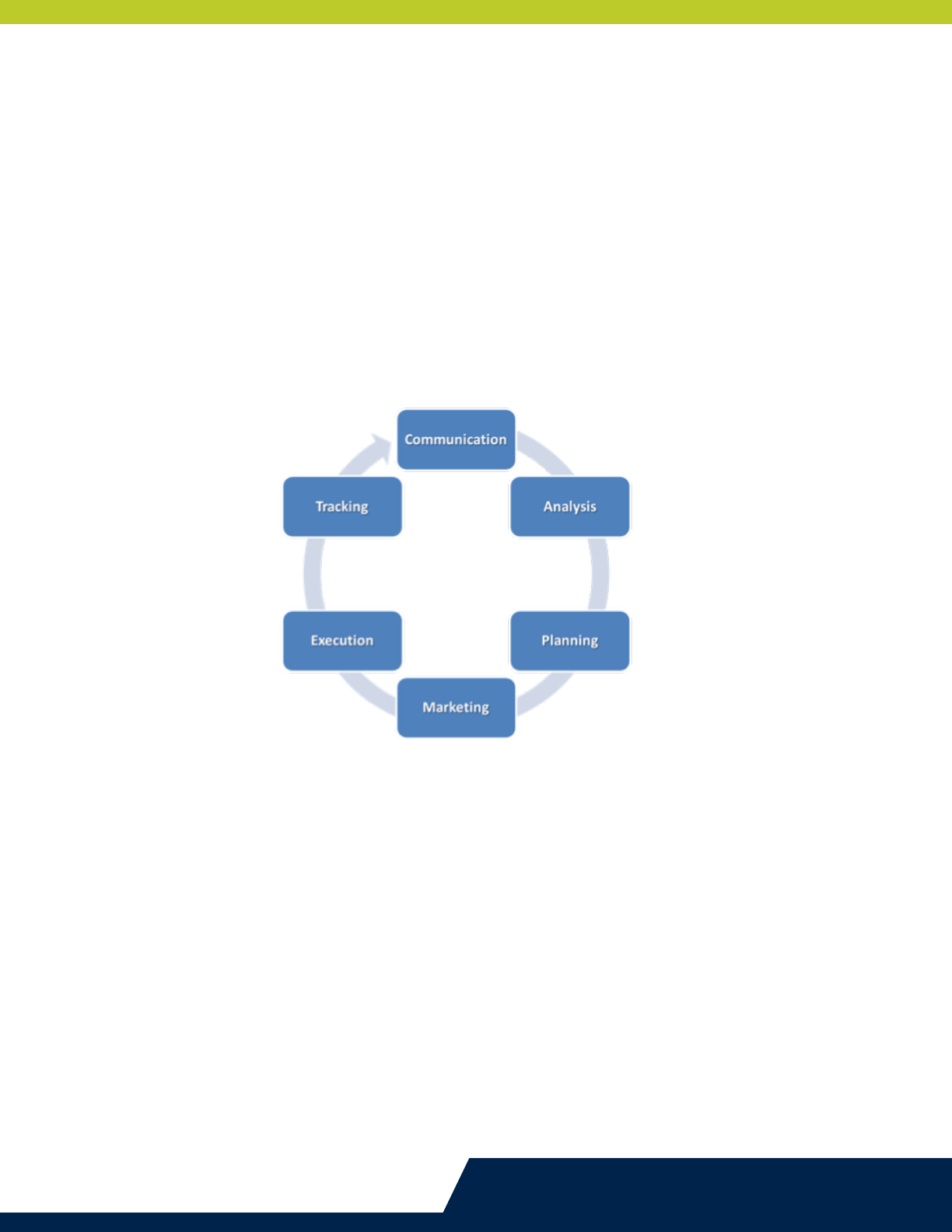
GOLF 2.0 PLAYER DEVELOPMENT PLAYBOOK
Player Development Action Steps
1. Communicate with Employers
2. Analysis of Player Development and Local Market
3. Create a Player Development Business Plan
4. Local Marketing – Generate Students and Customers
5. Player Development Execution – Where the Rubber Meets the Road
6. Track & Report Results
The Cycle of Player
Development Excellence
The pathway to Player Development excellence is based on the above action steps.
Although these processes happen in an orderly manner, some of the above steps
are ongoing, such as communication with your employer. Even by activating
on select steps, you’ll be making an impact to improve your business.
By Completing These Action Steps, You Will:
• Quantify the number of new customers you have created, plus how much they play and spend
• Gain increased commitment from your employer to support Player Development programs
• Strengthen the relationship between you, as the PGA Professional, and your employer
• Create a solid foundation for your golf future
6

Communicate with Employers
Player Development is a key component to growing rounds for your employer/management
team and direct report. Those PGA Professionals who have Player Development programs
need to communicate the actions they are taking to be revenue generators for their employer.
However, many employers are unaware of the positive benefit that a PGA Professional adds
to their bottom line. PGA Professionals who have a strong Player Development system need
to communicate to the employer the specific programs they are executing to create new
customers and the impact these programs have on rounds played and incremental revenues
generated to the facility’s bottom line. By better communicating how you are positively
impacting the number of customers and rounds played at the facility through Player Develop-
ment programs you’ve directed, your skills as a revenue generator will be better recognized
and you’ll be more valuable to your employer. This should lead to increased prosperity and
job security.
Why Communication is Key
To truly showcase yourself as the expert leader, it’s vital that you communicate results on
a national and local level. Your communication should include:
Industry Trends - Provide broader perspectives on industry trends and quantified results from
nationally branded Player Development programs. Information and research from Golf 2.0 will
help provide a better awareness about these trends and understanding today’s consumer, plus
insight into the eect that successful Player Development programs can have to a facility’s
bottom line. This research will detail:
• Three core strategies:
• Retain and strengthen the existing core golfers
• Engage the 61 million “lapsed”
1
golfers who still have an interest in playing
• Drive new players
• 12 strategic initiatives focused on these three core strategies
• Nine consumer groups – Targeted audiences with optimum demographics
identified by Golf 2.0 research
What to Communicate
1
”Lapsed” is defined as someone who used to play golf but has not played a round in the past 12 months.
7
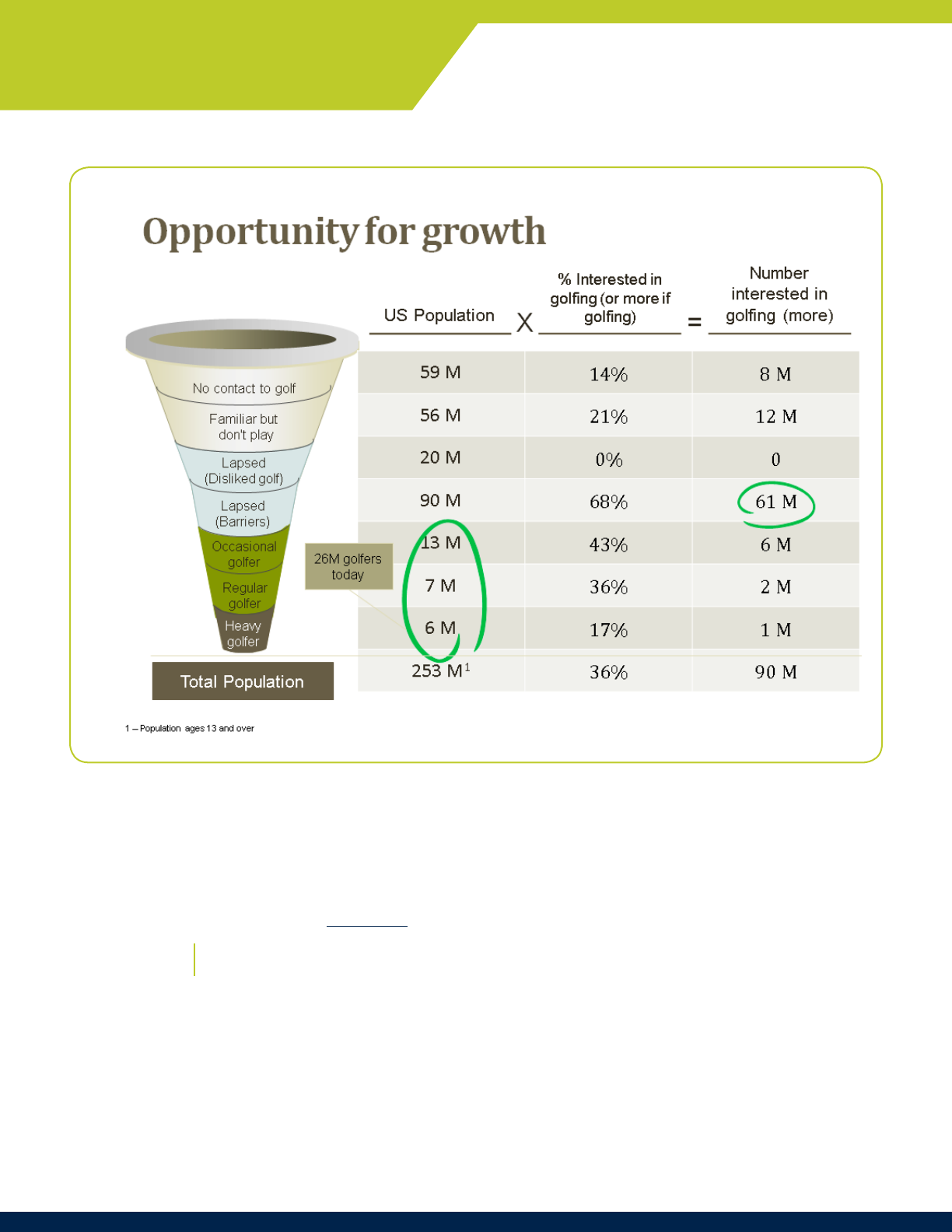
To be positioned as the leader, PGA Professionals should maximize how they use Golf 2.0
information and resources in communication with employers. Plus, you are encouraged to
provide employers with direct access to this valuable information by:
• Directing them to Golf20.net
• Username: golf2.0
• Password: growgolf
• Providing monthly issues of PGA Magazine, which are available digitally
• Register your employer to receive the new PGA Magazine Insider
edition, also available digitally
COMMUNICATE WITH EMPLOYERS
8
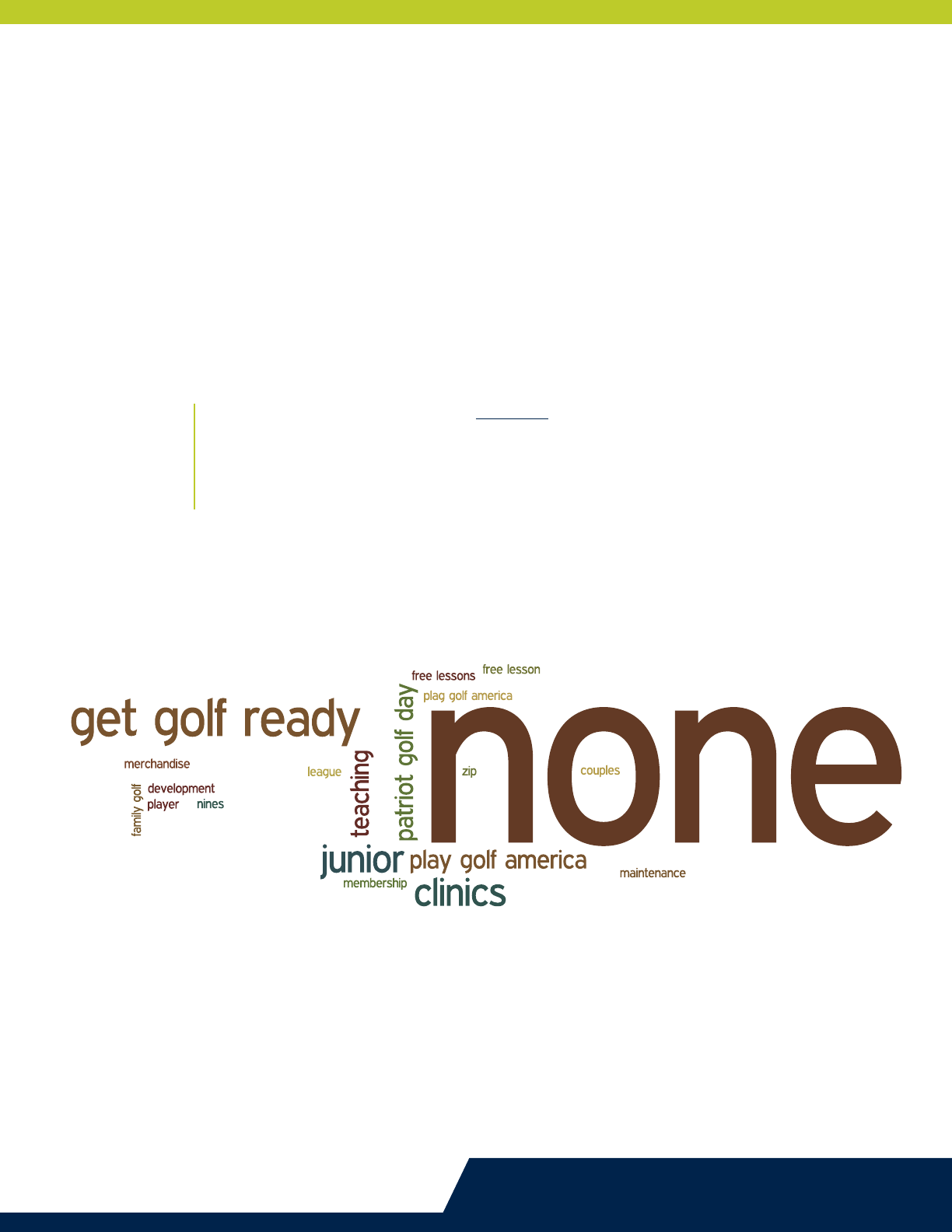
GOLF 2.0 PLAYER DEVELOPMENT PLAYBOOK
Your Plans & Results – Keep your employer well informed on your Player Development
planning, the results you have achieved and any challenges you faced. Let your em-
ployer know that you and your sta will be driving and delivering these programs and
you need their support. Show them the “Return-On-Investment” (ROI) of committing
resources to help create new golfers. Stress the “It’s Personal” of Golf 2.0, and that all
stakeholders should take responsibility to create new golfers.
• Share your business plan with your employer
• Share quantifiable results of your Player Development initiatives with
comparisons to your business plan and national benchmarks
National benchmarks will be hosted on Golf20.net (to be developed
by the end of 2012) and will provide averages for:
° Participation rates
° Retention rates
° Participant spending
• Provide updates of marketing plan execution and results generated
• Provide brief recaps at the conclusion of select programs on key successes
and challenges
The above word cloud represents responses from employers when
asked what Player Development programs their PGA Professionals
recommended and if these programs were successful.
9

GOLF 2.0 PLAYER DEVELOPMENT PLAYBOOK
How to Communicate
There are two basic types of communication to engage your employer/management
team and direct report.
Meetings – Face-to-face collaborations to maximize appropriate levels of involvement from
your employer. Types of meetings include:
• Preseason meeting to collaborate on Player Development planning for the year
• Consider quarterly meetings to review reports and keep employers informed
and engaged
• End-of-season meeting to review the year and identify challenges/opportunities
for next season
Example: Facilities in cold-weather states should schedule their preseason meeting in
March and facilities in warm-weather states should schedule their preseason meeting
in October
Reports - Communication of program performance to keep your employer informed.
• Deliver brief updates on observations of success stories from your programs
Example: The food and beverage team contributed with a cookout after the event.
All students stayed after hours for additional drinks and group camaraderie, and in
turn had increased fun.
• Provide quarterly/monthly reports detailing results achieved from Player
Development eorts
• Keep your employer updated with fresh industry research from Golf 2.0
on national Player Development results
10

Analysis of
Player Development Programs
and Local Market
An analysis of your existing Player Development programs and of the local market will help you
identify the factors that are working for and against Player Development. Understanding these
factors is important as it will help you:
1. Identify strengths and deficiencies in your current Player Development programming
2. Help your employer understand the environment you’re working in to develop
new customers
3. Establish attainable goals for success in future Player Development programs
4. Develop a targeting plan of preferred consumer segments, organizations and current
golfers that will be most interested and likely to act upon (or tell their friends and family)
about your messages to learn how to play golf or how to play golf better
Why Analyze Your Player Development
Programs and Local Market
Perform an analysis of all internal factors at your facility and external factors in your local
market that influence the success of your Player Development programs.
Internal factors to consider:
• Planning process for developing and executing Player Development programs
• Customers
• Current Player Development programs – types of programs and results
• Budget
• Instructional team
• Sta
• Marketing
• Atmosphere - how welcoming you and your sta are to non-golfers
What to Analyze
11

In addition to understanding your internal operations, it is important to do a thorough analysis
of your local economic, demographic and market conditions. The data and insights that emerge
from such a study can be used to help shape your overall strategy.
Understanding the demographics of your local population
• Average income, unemployment levels
• Average age range, number of schools
• Ethnic and gender breakdowns
Understanding the “latent demand
1
” for golf within your community
Identify opportunities for community-based marketing or relationships, (i.e., where
you are likely to locate your target consumer groups)
• Principal businesses and employers in your region
• Major community clubs, local corporations and social organizations
• Take inventory of your current relationships (i.e., companies or organizations
that currently use your facility for leagues or outings)
• Recreation departments
• Senior groups
• Higher education systems
Be aware of your local PGA Section and their current Player Development initiatives;
consider how you can piggy back on them
Understanding the competitive landscape in your area
• Number of other golf facilities, types, and their programs and services
• Performance comparisons with other golf facilities (Use PGA PerformanceTrak)
• Major recreation and leisure alternatives to golf
External Factors to Consider
1
“Latent demand” quantifies the level of consumer interest in playing golf or interest in playing more.
AnAlysis of PlAyer DeveloPment ProgrAms AnD locAl mArket
12

GOLF 2.0 PLAYER DEVELOPMENT PLAYBOOK
How to Analyze
Internal
To conduct your internal analysis it is best to utilize a SWOT analysis, a traditional business approach.
Through this process you will analyze four dierent areas of your Player Development eorts: Strengths,
Weaknesses, Opportunities and Threats. This approach will help you develop a realistic assessment of
what works well, and even more importantly, what could be improved.
This critical step will be used in the development of your business plan and objectives as well as your
marketing plans. You will want to capitalize on your strengths, minimize weaknesses, take advantage
of opportunities and neutralize threats.
See the Appendix for a SWOT Analysis Guide (found in Playbook Appendix), including a series of
self-assessment questions you can use to assess internal and external factors and their influence
on your Player Development programs.
STRENGTHS
• Commitment to Player Development already
exists at the facility
• Great team of highly qualified PGA and
LPGA Professionals
• Most of the Professionals are currently oering
programs targeted to women and new golfers
• Management’s desire to enhance Player
Development commitment and drive results
• Quality facilities
OPPORTUNITIES
• Enhance strategic approach to Player Develop-
ment – planning and collaboration between man-
agement and professionals
• Develop and implement plans for retention
• Provide instructors with incentives for creating
new golfers and getting them to play
• Learn more about existing customers and students
• Activate a system to track results - consolidate
student records into central database for market-
ing and tracking purposes
• Expand eorts to welcome new golfers
- website, signage, sta training
• Enhance use of existing facilities – one facility
is an executive course, another has nine
holes being underutilized
• Utilization of national programs and best practices
WEAKNESSES
• Management feels the instruction has under
-performed – not creating new golfers
• PGA and LPGA Professionals are independent,
thus there has been limited collaboration
between one and another and management
• No systems in place to track results – as a result
there was no quantifiable evidence that the in-
struction programs are having an impact
on golf course revenues
• Limited proactive messaging and marketing
eorts to bring in and welcome new golfers
THREATS
• Missing opportunities for potential synergies
between management, Professionals and
facilities to collaborate for planning,
marketing and programming
• Lack of planning and not having strategies
to turn students into golfers
• Not accounting for impact of Player
Development programs
• Lack of communication with students to
keep them coming back
• Inconsistent messaging being delivered
by frontline sta
• Professionals not having a vested interest
in generating rounds of golf
EXAMPLE SWOT ANALYSIS
13
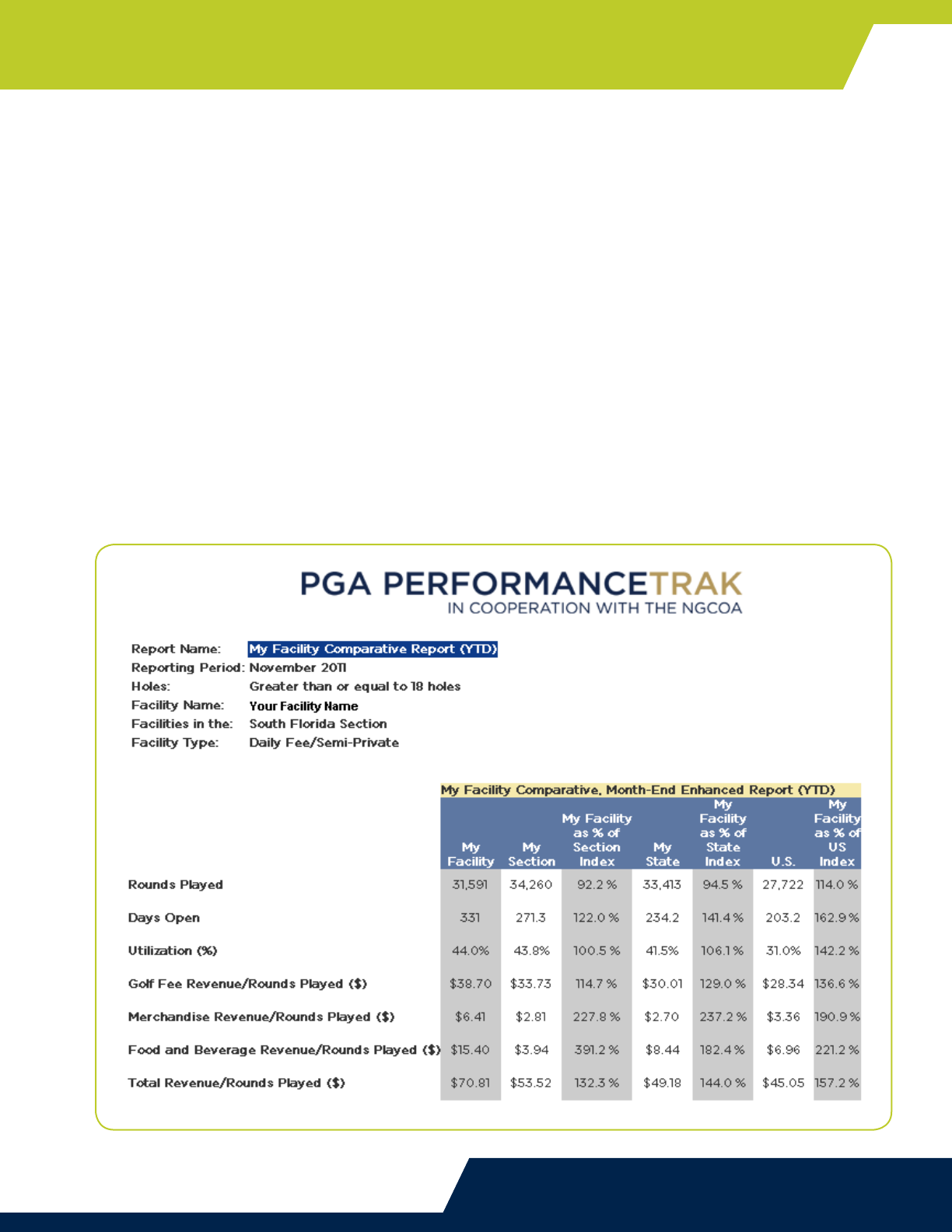
GOLF 2.0 PLAYER DEVELOPMENT PLAYBOOK
External
Completing the external analysis will allow you to better understand your local market.
Some suggested resources include:
• Local, county, state and federal government agencies – either visit in person or check online
• Department of Commerce or Department of Labor
• Local and County Chamber of Commerce
External analysis data can be used for the following:
• Identifying which of Golf 2.0’s nine consumer groups are most prevalent in your local market
• Identifying businesses, schools, recreation centers and community organizations
Example: There is a demographic overview of Louisville, KY that was found online included in
the Appendix (found in Playbook Appendix). This overview would provide a facility in Louisville
with customer profile information on population demographics, ethnic breakdown, age ranges,
genders and income levels and how this data has trended over the last 10 years.
PGA PerformanceTrak is an excellent resource to help analyze your rounds and revenues relative
to similar facilities in your market, Section, state and the country.
AnAlysis of PlAyer DeveloPment ProgrAms AnD locAl mArket
14

Create a Player Development
Business Plan
“Failing to plan is planning to Fail.”
This traditional proverb is simple and says it all. But in reality, if you fail to plan each year, there
still is a chance you would generate some results through Player Development. However, if you
want to maximize the impact of your eorts, and do your best to tap into the 61 million lapsed
golfers who still have an interest in playing, a well thought out and documented plan will be your
roadmap to greater success.
As American culture has evolved, the wants, needs, expectations and time availability of consum-
ers has changed. Golf 2.0 is strategically responding to the evolution of our society as it strives to
change the culture of golf by making the game more appealing to a wider range of Americans.
Please recall how the introduction of this Playbook identified the “It’s Personal” call to action
for you, the PGA Professional. Through well-developed plans, you will be taking more personal
control over your employment destiny by generating business through Player Development. This
planning process is your foundation for enhancing your leadership role, embracing opportunities
to create cultural changes in the game and personally taking control of your future.
Why is the Planning Process Important?
•Core Strategic Framework
•Objectives
•Programming Functions
•Budget
What Should be Included in Your Plan?
15

Core Strategic Framework
The beginning of your plan should be a series of statements providing a high-level description
into why your Player Development programs exist and the actual business you are in. Compo-
nents include:
• Mission Statement: A brief statement of your purpose that should guide the actions
and direction of your Player Development plans
Example: To be respected by the community and our peers as the leader in golf instruction
by providing opportunities for new and existing golfers to learn, grow and play in a fun,
safe and comfortable environment.
• Vision Statement: Description of what you want to be in the future
Example: To coordinate self-sustaining Player Development programs that also serve
as a profit center for my facility by oering world-class service, instruction and learning.
Objectives
Establish quantifiable objectives to serve as benchmarks for success. These should be
aggressive to help generate a meaningful impact, yet realistic in relation to the resources
you have dedicated to Player Development. Your SWOT analysis should be used extensively
when setting your objectives.
Always start with setting objectives that have the biggest impact on your facility’s business:
• Number of new golfers generated, percentage of women
• Number of rounds played by new golfers, percentage of women
• Number of family rounds played
• Number of junior rounds played
• Membership sales
• Revenue generated from Player Development programs
• Tee times
• Merchandise
• Instruction
• Food & Beverage
Set programming objectives on helping to achieve desired results through:
• Number of classes
• Number of participants, percentage of women
• Percentage continuing in next level instruction
• Percentage continuing in structured play programs
• Set Specific Meaningful Achievable Realistic Time-Oriented (SMART)
goals for specific number of students
CREATE A PLAYER DEVELOPMENT BUSINESS PLAN
16
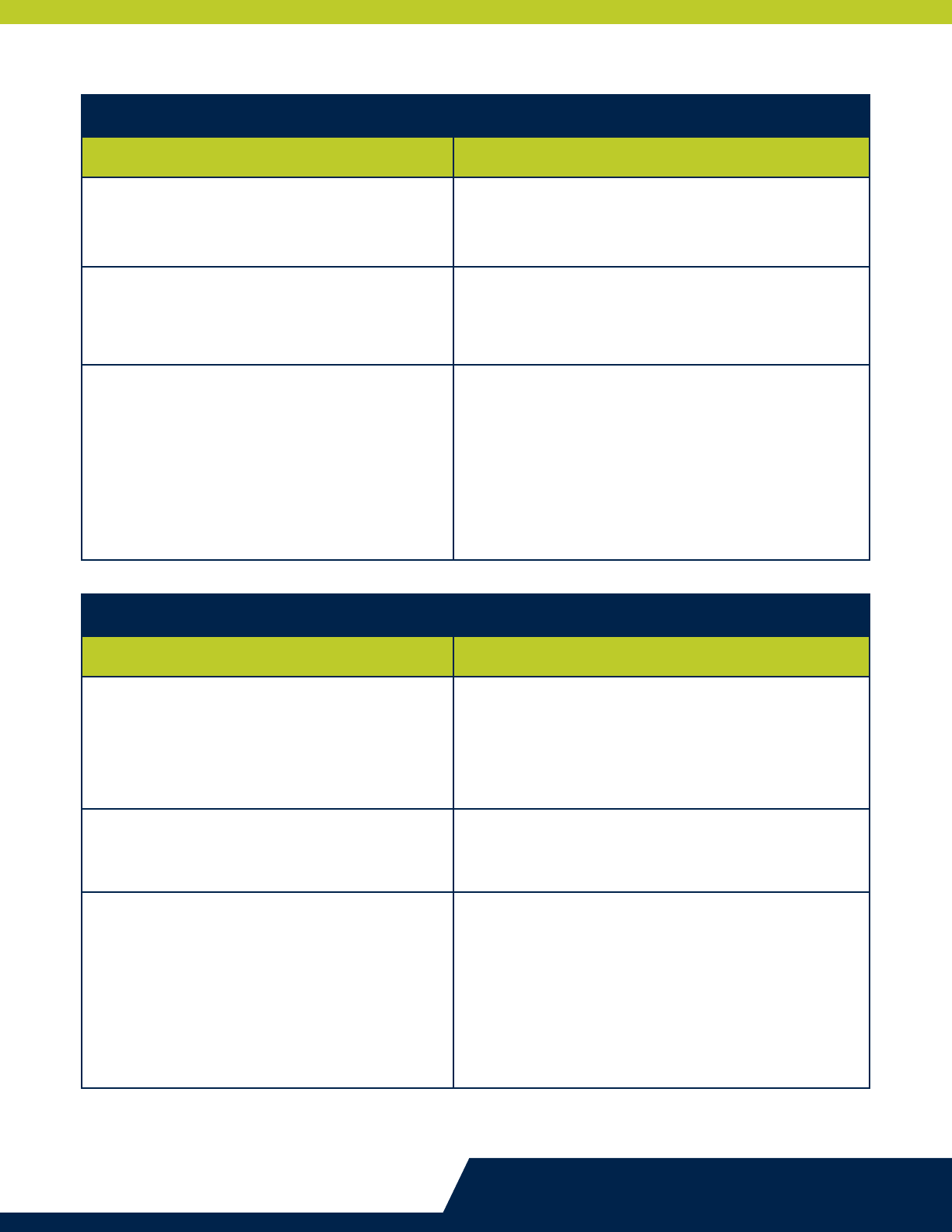
GOLF 2.0 PLAYER DEVELOPMENT PLAYBOOK
17
PGA Professional Compensation
Desired Outcomes Example Objectives
Generate new golfers
• 200 new golfers will graduate from GGR
• 85% will be new or former golfers
• 75% will be women
Generate rounds from new/former golfers
• 80% will play golf
• Each will play an average of 10 rounds
• Totals 1,600 rounds
Generate spending on other golf services
• Golfers will spend $800 annually on golf
•Additional instruction
•Tee Times
•Equipment
•Apparel
•F & B
• $128,000 in new revenue
Adult Player Development – Get Golf Ready
PGA Professional Compensation
Desired Outcomes Example Objectives
Get juniors playing golf
• 150 kids in Junior Camps
• 75% will be new or former golfers
• 50% will be girls
• 80% will participate in junior play programs
Get juniors playing with families
• 80% will play with their families
• Each family will play an average of 5 times
Generate spending on other golf services
• Juniors will spend $300 annually on golf
•Additional instruction
•Tee Times
•Equipment
•Apparel
• Families will spend $250 annually on golf
• $75,000 in new revenue
Junior/Family Development

Programming Functions
The body of your plan should detail various programming functions, identify what you want to
accomplish, who will be responsible and appropriate timelines. Plans should also serve as your
roadmap toward achieving your objectives.
There is an example Business Plan from Saguaro Sands Golf Links found in Playbook Appendix.
Programs: Identify programs that you plan to oer throughout the season. Consider what
programs are best for each of your target groups. Your programs must be fun and address
barriers keeping these groups from playing:
• Retain Core (Ex. TEE IT FORWARD)
• Engage the Lapsed adults (Ex. Get Golf Ready, Welcome to Golf Month, It’s Okay)
• Programs for Women (Ex. Get Golf Ready for Women, Couples Leagues/Nine and Dine)
• Programs for Families (Ex. Family Golf Month, Kids Play Free, PGA Family Course)
• Programs for Juniors (Ex. PGA Sports Academy/Junior Camps, Junior Leagues)
• Programs for Seniors (Ex. TEE IT FORWARD, Get Golf Ready)
NOTE: These programs listed above are suggestions to select from, (i.e., plan to oer those
appropriate for your facility and within your resource capability). A description of the Golf
2.0 Menu of Programs can be found in Playbook Appendix.
• To accent introductory programs, it may be more important to plan for retention
and ensure you provide programs for continued instruction and casual play
• Get Golf Ready 2
• Get Golf Ready Outings or Beginner Leagues
• Loyalty programs
CREATE A PLAYER DEVELOPMENT BUSINESS PLAN
CONNECTING WITH HER
Why is it important to host programs for women? As cited in Golf 2.0 research and emphasized
in the strategic initiative Connecting with Her, these statistics show evidence of the buying
power of females:
• Women control 73% of household spending
• 70% of new businesses are started by women
• Women account for 85% of all consumer purchases
• American women spend about $5 trillion annually - over half the U.S. Gross Domestic Product
For additional information and direction, see the Connecting With Her Playbook
to be developed in 2012
18

GOLF 2.0 PLAYER DEVELOPMENT PLAYBOOK
Stang: To truly maximize success and potential ROI, a critical component is to have
the best possible PGA Professionals and sta focused on Player Development
• You need to plan to have PGA Professionals with a strong dedication towards Player
Development and provide them the resources to be successful. Options include:
Appoint a Director of Player Development. (i.e., a PGA Professional dedicated
exclusively to Player Development. A sample Job Description is found in
Playbook Appendix
Update job descriptions (or agreements with independent contractors)
to ensure your instructors are aligned with plans for Player Development
If possible, it is best to have someone other than your PGA Head Professional
in this role, as they can focus more attention on Player Development and
generating revenue
Example: Carolina Golf Trail recognized the importance of bringing new golfers to
the game and appointed a PGA Apprentice on their current sta to serve as Director
of Player Development. Directed to focus exclusively on Player Development, this
professional generated more than 700 new golfers through Get Golf Ready alone
in 2011 using the steps outlined in this Playbook.
• Plan to have sucient support sta to help deliver and maximize success
of your programs
Use sta at the facility
Bring college or high school students to assist with junior camps/programs
Use your best customers as ambassadors/mentors, (i.e., a great resource to take
new golfers onto the golf course for play days, etc.)
Secure PGA Life Members and independent contractors to help deliver instruction
Marketing Plans: Marketing and local promotional eorts are so vital that the
Local Marketing Section is dedicated to help guide you to maximize your plans in this area.
Recommended strategies will include:
• Community marketing
• Special events
• Direct marketing
• Digital and Social Media
• On-site marketing and promotions
• Cross promotions between Player Development programs
• Public Relations
• Advertising
19

CREATE A PLAYER DEVELOPMENT BUSINESS PLAN
Scheduling: This is an important area that’s often overlooked. Though it can be time consuming
and tedious to change/alter, it’s nevertheless a critical component. There are two basic
approaches toward planning your schedules:
• Pre-schedule programs and promote
Schedule based on when target consumer groups would be available
Example: For working adults, have programs in the evenings and on weekends; focus on
weekends and summers for kids and families; and seniors may be more likely to
participate on weekday mornings
Consider time of day, week, year, length of instruction for each target consumer
group Consider golf course and range needs and access
Have programs scheduled at as many dierent times as possible for
student accessibility
• Sell programs to dierent consumer groups and set classes/lessons
that fit everyone’s schedule.
Example: Get Golf Ready to eight students at the same company
Golf Course/Practice Facility Access: Coordinate your programming with various members of
your operations team to ensure your students have a comfortable, welcoming experience
• Review the analysis of your physical plant (golf course, range) to ensure you are as
welcoming as possible
Consider how you can provide students with short-course experiences (i.e., PGA Family
Tees, practice holes, retro-fitting your range to create a bunny slope/learning course)
Consider how you can provide access to play non-traditional rounds (3-hole loops, 6-hole
loops, pay on a per-hole basis, etc.)
Schedule times for new golfers to access these areas free of intimidation and sharing the
golf course with existing golfers
Example: At a course in Ithaca, NY, Get Golf Ready graduates can pay $2 per hole to play
after 6:00 P.M. every night. By this time all of their leagues are on the course and the tee
is usually empty, thus these newer golfers can take their time while building confidence
and skills. With the per-hole option, these golfers feel they are getting a good value. This
has generated an extra $7,000 in green fees, which does not include their F&B purchases.
• Ensure all sta are aware of programs and your facility is ready to accommodate
the activities
Days the driving range are closed for mowing/maintenance
Tournaments/events/leagues that could interfere with your
ability to utilize facility/range
20

GOLF 2.0 PLAYER DEVELOPMENT PLAYBOOK
• Be creative in planning to maximize on-course experiences for all of your programs, espe-
cially Get Golf Ready
Plan to provide Get Golf Ready students with access to on-course experiences as part of
every session (i.e., quick drills or games they do on-course). For example, bring students
to an actual green for a putting contest, or use an open hole for them to hit approach
shots using irons
Fee structure for shorter playing opportunities (i.e., 3-hole, 6-hole, etc.)
Create “bunny slopes” and other “short course” versions for beginners to increase
demand, utilization and exposure
• Review your rules and policies to make sure you are providing a welcoming experience. Are
you willing to change? You need to think about the norms of today’s society, as well as the
traditions of golf:
Can your dress code be updated?
Do you allow cell phones on the course? If you did, would it increase play?
Do you require every golfer to have their own set of clubs and bag? If so, why?
“When We sit doWn to go through the calendar i look at player development pro-
grams. in particular, Where to place our get golF ready programs and maximize our
participation. By going through this process at the Beginning oF the year, it alloWed
us to increase participation From 89 students in 2010 to 227 students in 2011.”
– Jon goin, pga, tpc southWind
Budget
Every plan relies upon a budget to forecast ballpark figures. For Player Development, this process
allows you to estimate the desired net impact to your bottom line based on the participation
objectives you’ve established. Feel free to use your normal budgeting process; however, you
should consider the following guidelines in ramping up your commitment to Player Development:
Develop budgets per program – keep it simple
• Revenues: Establish and project registration fees for each scheduled program
Determine what fees include (i.e., consider bundling green fees or equipment)
Determine how fees will be split between your instructors and facility
Consider if there may be potential for discounted rates (i.e., sell package
deals, promote through Groupon, etc.)
• Expenses:
Stang (i.e., instructors and support sta)
Course/range fees
“Welcome packet” giveaways to students
21

Forecast annual budget – Project net impact to bottom line
• Account for individual program budgets
• Annual Stang
Instructors
Administrative
• Incentives
• Promotions and marketing
Materials development (brochures and posters)
Advertising
Special events
• Demo equipment (i.e. clubs, balls)
Compensation for Instructors: It is highly recommended that you oer incentives for
your instructors to get students playing golf. Elements you need to consider:
• Pay your instructors a base salary as a way to ensure they are dedicated to Player
Development and bringing new golfers into the game.
• The facility could take a percentage of instruction revenue as a way to justify the
investment of paying a base salary.
• Most importantly, you should oer some type of financial incentive encouraging your
instructors to promote next-step playing opportunities, and ensure they get their
students coming back.
Example: To achieve objectives to get new golfers playing, The Carolinas Golf Trail
restructured a compensation package for their newly hired Director of Player
Development. They paid a significant base salary, but split 65% instruction revenue
to the facility and 35% to the instructor. They also paid the instructor $10, or 50%
of paid 9-hole green fees, from these students, for up to 10 rounds.
Sample Compensation Plan:
• Based on generating a total of $80,000 in instruction revenue
• The net instruction income to the facility would be approximately $12,000
• Total revenue to the facility would actually be much greater as this figure does not take
into consideration ancillary income via merchandise, range, green fees and F&B sales
• A complete Player Development Budget Template/Worksheet is found in Playbook Appendix
CREATE A PLAYER DEVELOPMENT BUSINESS PLAN
Base Salary $30,000
Commission: 35% of all gross revenue instruction $28,000
New Golfer Commission: Assume 100 new golfers play 5 rounds $5,000
Bonus $5,000
Total compensation $68,000
22
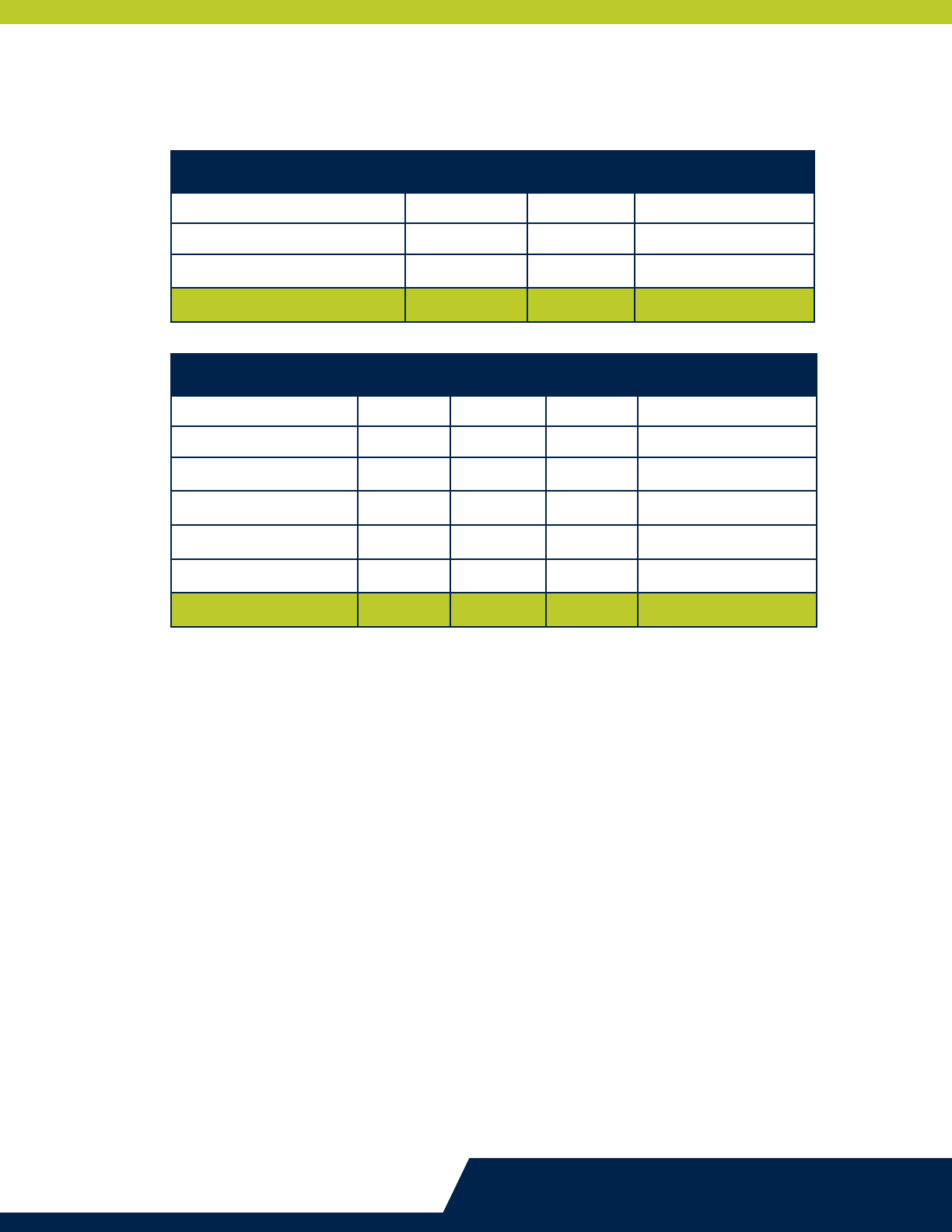
GOLF 2.0 PLAYER DEVELOPMENT PLAYBOOK
PGA Professional Com- PGA Pro-
Students Fee Total Rev
Get Golf Ready 250 $99 $24,750
Get Golf Ready2 110 $99 $10,890
$35,640
PGA Professional Compensation
PGA Professional PGA
Students Visits Spend Total Rev
Retained Students 210
Greens Fees 191 12 $284 $54,272
Range Visits 193 9 $68 $13,138
Equipment 166 $270 $44,793
Apparel 147 $120 $17,640
$129,843
Facility Revenues
Developing Strategies and Objectives from Your SWOT Analysis
Focus on identifying competitive advantages by matching strengths to opportunities.
The following is an example situation of using your SWOT:
1. A strength is your outstanding team of Professionals
2. An opportunity you identified through your analysis is 20 businesses with 100 employees
or more are within 10 miles of your facility to whom you have never marketed your
Player Development programs
3. A marketing strategy would be inviting the Human Resources Manager at each
company and a guest for a free day of golf or complimentary access to Get Golf
Ready to learn how to play golf. Your message is that golf oers many wellness
ben efits and that you want to spread those benefits to residents and employees
in the community.
4. Your objective is to have relationships with 10 of these businesses, each
sending eight students for your Get Golf Ready Program
How to Develop your Plan
Get Golf Ready Financial Model
Based on 250 Students:
23

GOLF 2.0 PLAYER DEVELOPMENT PLAYBOOK
CREATE A PLAYER DEVELOPMENT BUSINESS PLAN
• Create strategies and objectives for every competitive advantage you find
• To determine your total goals, combine the objectives from your new strategies
with the past performance of your historical programs
Example: Last year 50 new golfers were developed through Player Development
programs. This year, you have five new strategies from your SWOT analysis with a
goal of 100 new golfers being created from these new strategies. The net facility
goal for new golfers developed this year would be 150 (50 from last year + 100
from new strategies this year).
You must also identify strategies to improve weaknesses and protect yourself from
threats when possible
Example: You have a great instruction program, but you identified a weakness - not
many of the students were coming back to play. The threat of not doing something
about this is losing these students to other courses, or other activities. To address
this, you need to be strategic and have specific plans to get them playing – direct
invitations, fun programs, special deals and even incentives for instructors.
Key Approaches
The planning process should be a collaboration between you, your employer, and
any other lead PGA Professionals or sta. By their active involvement in the planning
process, you will increase the likelihood of their active participation and sense of
ownership in your Player Development eorts.
Review the Golf 2.0 Menu of Programs at the end of this Playbook. This menu
provides proven options for you to select. Consider adopting programs in their
entirety, or integrate elements to help enhance your current eorts.
There is an example Business Plan from Saguaro Sands Golf Links
(found in Playbook Appendix).
24

GOLF 2.0 PLAYER DEVELOPMENT PLAYBOOK
Player Development Execution
Where the Rubber Meets the Road
Why Quality Execution Matters
“It may be more Important to teach people how to have fun;
the golf skIlls wIll follow.”
ted bIshop, vIce presIdent, the pga of amerIca
Each of the steps in this Playbook takes a significant amount of eort but can result in a logical
and realistic road map towards success. Some of your lead objectives should be attaining desired
numbers of students entering your Player Development programs and the number retained as
golfers. How well you execute this step, will be the determining factor on if you’re able to reach
the objectives you set in the Planning Step.
Hiring Right – Why it Matters
The instructors you hire for your Player Development programs have the single greatest impact.
They are responsible for delivering the best experience possible. They are your lead contact for
making golf fun and establishing long-term relationships. Considering the influence they control,
make sure you have the best people possible.
Training Sta Right – Why it Matters
Hiring the right instructor alone is not enough. You need to make sure all your sta takes
ownership of your objectives and you train them on the steps they need to complete to get
there. If sta isn’t trained on what your objectives are and what they need to be doing to
attain those objectives, the likelihood you’ll reach your goals is slim.
Scheduling Right – Why it Matters
It’s important to have a sound method as to how you are scheduling your Player Development
programs. By scheduling programs that meet the needs of your intended audience, you’ll have
higher counts of enrollees.
31

PLAYER DEVELOPMENT EXECUTION - Where the Rubber Meets the Road
Marketing Right – Why it Matters
A key part of the equation as to how successful you’ll be in attracting students to your Player
Development is your marketing. Sending impactful messages to people interested in being out-
doors, enjoying a social atmosphere with friends and family, and playing a fun sport will result
in your messages converting into students. How impactful your message is and your ability to
deliver it to as many interested people as possible will be the determining factors in your level of
success in attracting students.
Retention – Why it’s the Ultimate Measure of Your Skills as a Revenue Generato
The business justification of Player Development programs is that you will be bringing new
customers to your employer. Yet, if you’re unable to retain students as golfers, this promise of
added customers will fall apart. You can develop a strong marketing and Player Development
business plan, but if you’re unable to eectively execute these plans, retention will suer, and
you’ll add less value to your employer than you could have. At the end of the day, the number of
golfers you develop and retain is your ultimate measure of how successful you are at generating
revenue for your employer through Player Development.
What’s Needed to Execute Your Plan
You’ve built a personal Player Development plan. It’s time to progress from a planner
and become a revenue generator.
To do so, you need to:
• Commit to your plan
• Maintain enthusiasm throughout all programs, being enthusiastic and positive
is just as important for retention as it is for the introduction of programs
• Dedicate time to your marketing plan – drive the success
• Have the right people
• Expand your database – collect contact information and profiles of students
• Have regular follow-up communications with your students
How Do You Execute – Keys to Success
Make it FUN, make it FUN, and make it FUN!
• Hiring for fun! - Hire friendly instructors who exude warmth and have a passion
for the game and a desire to spread that love of the game to others. Key traits
to look for when hiring to make it fun are:
Someone who loves the game
Enthusiasm about helping others
Excellent interpersonal and communication skills
Strong presentation skills – important for presenting the fun qualities of the game to
senior business executives when marketing
32

GOLF 2.0 PLAYER DEVELOPMENT PLAYBOOK
• Sta training for fun! - From the time a student arrives in the parking lot until the time
they leave the property, every sta member who encounters a customer (golf shop sta,
outside operations sta, food & beverage sta) should be dedicated to exuding a fun and
welcoming atmosphere for all students
Work with sta to cultivate their ownership and pride in your
Player Development programs
Communicate details and schedules of your programs
• Programming for fun! - When executing programs, be creative in how you can
make the overall experience more enjoyable
Use “games” to develop skills vs. “drills”
Incorporate contests into your skill development
Make it welcoming
• Hire friendly sta who express a genuine desire to help others enjoy golf
• Training to make it welcoming
Remind sta the most important thing they need to do is make it fun!
Train sta on how intimidating golf can be to non-golfers if sta is not paying
extra attention to guide and coach beginners on what they should be doing
Coach and role-play with sta on what to do and what not to do
Consider a secret shopper to visit your facility or using a customer survey
to ensure quality control
• Marketing a welcoming atmosphere
Have your marketing messages show, both in text and in photos, people learning
how to play and being taught from dierent ages, genders and ethnicities
Use your website to promote – New Golfers Welcome!
• Make sure your physical plant/golf course is set up to provide a welcoming
and enjoyable experience
Consider how you can provide students with short-course experiences (i.e., PGA Family
Tees, practice holes, retro-fitting your range to create a bunny slope)
Consider how you can provide access to play non-traditional rounds (i.e., 3-hole
loops, 6-hole loops, pay on per hole basis, etc.)
Schedule times for new golfers to access these areas free of intimidation
and sharing golf course with existing golfers
33

Keep it easy and aordable
• Let students know when they register that you’ll provide them equipment
if they don’t have clubs. Give them golf balls as well!
Each student doesn’t need a full set of clubs, but they do need at least
a couple of clubs. Have at least a few left-handed clubs available, too
• Have aordable registration fees. Get Golf Ready and introductory programs
in many respects are more about marketing the game than teaching golf skills
It is vital to keep your fees reasonable – use an aordable approach
to get new golfers hooked
Example: In establishing Get Golf Ready registration fees, most facilities charged the
recommended $99 as it is aordable. With eight Get Golf Ready students this still
averages to more than $100 an hour for the instructor. Plus, as students progress
into Get Golf Ready 2 and higher level instruction most facilities raise their pricing
to be more in-line with their other “per-person” instruction rates.
Do the Math: Get Golf Ready – Revenue Breakdown
Students 8
Registration Fee $ 99
Total Revenue $792
Hours per Class 1.5
Total Classes 5
Total Hours 7.5
Revenue per Hour $105
Consider daily-deal websites for Player Development programs such as Groupon
or Living Social. If you’re concerned about discounting, at least consider using
these tools during the shoulder/o season.
• Consider special deals for customer retention
Oer a free short round (3-hole scramble event) to get the customer back to
the course after their Player Development program
Sell a package of green fees or include in registration fees
Some Get Golf Ready facilities even include rounds of golf with their registration fee
Consider bundling other services or products within your fees – give your
students great value
Example: A facility in the Pacific Northwest Section bundles other benefits within their
Get Golf Ready registration fees and has two options. For a base price of $149, students
receive the standard five lessons, plus three additional rounds of golf. For $249 (an ad-
ditional $100) students can also walk away with a set of beginner golf clubs.
PLAYER DEVELOPMENT EXECUTION - Where the Rubber Meets the Road
34

GOLF 2.0 PLAYER DEVELOPMENT PLAYBOOK
• Scheduling to make it easy
Schedule Player Development sessions at times that your intended audience can
participate (juniors during summer break or on weekends; seniors during weekday
mornings; and employees at businesses after work or on weekends)
Get people playing on the course
• Your goal should be to get students on the golf course as quickly as possible
• Students are there to learn how to play golf, not necessarily perfect a golf swing
• Maximize use of “It’s Okay” and TEE IT FORWARD to help golfers have more
success and fun while playing – (found in Playbook Appendix)
Create relationships with your students
• Make a friend not a sale - when the customer sees you as their friend, they’ll
go out of their way to do business with you
• Be strategic in capturing contact information of students, so that you can
continue a coaching dialogue with them
Capture a variety of customer profile information about demographics and passion level
for the game, and their future goals as a player
• The Get Golf Ready resource page has a built in event scheduler, with capabilities of on-
line registration and data collection
CONSUMER CUSTOMER CLIENT PARTNER
Relationship Building Approach
This is a common relationship-building approach shared in PGA Education. It is simply
a way of thinking through a strategic process to grow your business.
• First, you think of the target market that is available at your facility (i.e., “consumer” groups)
• Second, as you have attracted them to participate in your programs they are becoming
a “customer”
• Third, have the follow-up programs designed and ready to implement so the customer
is inclined to return for another pleasurable experience, which makes them a “client”
• As you nurture the relationship by getting them to return again and again, your client
will eventually become a “partner,” which significantly increases the likelihood they
use you as their primary resource for everything golf
35

Local Marketing
Generate Students and Customers
Why Market
In the ‘80s and ‘90s golf was a lot like the movie “Field of Dreams.” If you build it, they will come.
Times have changed. Through the growth of the number of facilities combined with the chang-
ing culture of America, with more pressures on time and money for consumers, it’s your personal
responsibility to get the local community excited about golf.
Other recreational sports that compete with golf have faced similar challenges where consumer’s
wants have shifted over time. Bowling was able to respond to the evolving needs of their custom-
ers through bumper bowl and thunder bowl. Skiing also faced similar challenges but was able to
grow consumer participation by embracing snowboarding. The lesson from these two industries
is clear - being in the recreational business, we must understand and cater our programming to
what the consumer wants, so we can retain current and reach new consumers.
It’s your job to position golf at the top of mind for consumers as a fun activity that they want to
play. There are 61 million former golfers that have expressed an interest in playing again.
It’s your personal challenge to connect with those Americans who are not currently golfers but
have shown an interest in returning and becoming golfers. The statistics noted above average to
some 6,000 potential new golfers for every PGA Professional-staed facility. You have a tremen-
dous opportunity to get this population of potential customers excited about playing golf at your
facility.
What to Market
You are marketing the game that you love and one of the greatest recreational activities available.
Your marketing messages should incorporate:
• The Game of Golf: Friends, Family & Fun!
• Your Programs
• Yourself
Golf is aordable
Golf is welcoming
Golf is good for your health
Your facility
25

LOCAL MARKETING - Generate Students and Customers
Golf 2.0 research identified that people enjoyed playing the game with friends and family
members. Therefore, your Player Development marketing messages must incorporate the social
nature of the sport and how the game’s atmosphere provides camaraderie among friends and
bonding between family members.
People need to know golf is good for your health while they play. Health and fitness experts
advocate that walking 10,000 steps per day – the equivalent of 18 holes or five miles – will improve
your overall fitness and help control your weight. This is a great message on why golf is good
for your health.
Non-golfers likely have some misconceptions about the game. Therefore, your messaging needs
to overcome these misconceptions by promoting that golf is aordable…can be played fast…is
fun…welcoming to all races and genders…and provides a beautiful and environmentally clean
atmosphere to enjoy being outdoors.
Who to Market to
The Boston Consulting Group has identified nine targeted consumer groups that are most likely to
have interest and capability to become golfers or to play more rounds at your facility. These nine
groups are:
• Regular golfers making at least $150,000 annually: This is a segment size of less than 1 mil-
lion people who have a high per-household spend and a high desire to bring others to the
game.
• Occasional women with no kids: This is a segment size of about 2 million people who have
high latent demand to play the game in some form. They have fewer barriers into the
game than moms and have a longer potential golf life versus retirees.
• Occasional men with no kids: This is a segment size made up of about 5 million people
who have a substantial latent demand to play the game. They have fewer barriers into the
game than dads and have a longer potential golf life versus retirees.
• Lapsed women with no kids: This is a large segment size of 17 million people who have an
extremely high latent demand to play the game.
• Lapsed men with no kids: This is a large target population of 26 million people who have a
relatively high latent demand to play the game.
• Lapsed retired men: This is a population of 10 million people who have a very high latent
demand to play the game and is a high potential household revenue opportunity.
• Lapsed dads and moms: This is a population of some 19 million people who have a high
latent demand to play the game and a high per-household potential revenue. They also
represent an opportunity to bring families to the game.
• Kids: This is a total population of 27 million people who represent a solid foundation for
the future of the game. Kids’ participation and interest enables the whole family to play.
• Hispanics/Latinos: This is a population of 24 million people who represent the fastest
growing ethnic group in the United States, with increasing wealth. The Hispanic/Latino
population skews young, which adds to future opportunity.
26

GOLF 2.0 PLAYER DEVELOPMENT PLAYBOOK
Visit Golf20.net for more information about each of these consumer groups and pay special at-
tention to their “pain points.” Pain points are simply the leading barriers keeping people from
playing golf, or playing more. Example most often cited include time, cost, significant-other does
not play, or people feel golf is not welcoming. It is important to know these, and market positive
messages to break these barriers.
When developing your marketing plan to these targeted consumer groups, you’ll get maximum
return on investment by utilizing your SWOT analysis and identifying organizations, businesses
and schools that likely contain these nine targeted consumer groups.
How to Market
In this Playbook, the phrase “It’s Personal” continues to be used. As stated earlier, your marketing
and promotions strategy will be personal. It is up to you to develop a plan where you can focus
on promoting the game and attracting consumers back to your facility, your program, and you.
The following is a menu of strategies that have been proven successful by other PGA Profession-
als. It’s up to you to review this menu and consider which strategies will serve you best based on
your facility, your business plan and your local market. To illustrate how to market using each of
these strategies, below are real-life examples your peers have used to help grow their business.
Community Marketing: It’s important for you to leave your facility and get out into the community
to promote the game and your facility.
Example: PGA Professional Ted Bishop has established a relationship with a local bank. In
working with their HR Director, he was able to sell Get Golf Ready as a health and wellness
program. As a result, the bank sends 20+ students to take Get Golf Ready at Ted’s facility each
year.
Example: As a newly hired Director of Player Development, Will Grant was on a quest to mar-
ket Get Golf Ready at his new facility. He identified 11 companies that hosted leagues at his
facility in the past. During the oseason he met with the HR Directors of each company to
promote Get Golf Ready. Through this eort, he generated more than 300 students in one
season.
Example: PGA Professional Phil Green approached the school board in his district and has
taken it upon himself to work with PE teachers in adding golf to their curriculum. He was
also instrumental in helping coordinate field trips back to his course, and in turn promotes his
junior and family programs. Phil has seen 1,000 kids from his school program transition to his
green grass programs each summer.
Other community marketing opportunities include community organizations, Parks & Rec.
departments, and local community colleges.
Special Events: Be creative in finding or creating opportunities to deliver golf experiences to large
groups of consumers. These golf experiences can take place at your facility, but they may be even
more eective when being conducted at a consumer event in your area.
Example: A group of nine facilities in Charlotte, NC took it upon themselves to host a Play Golf
America day on the same day in July, to include a cooperative approach to promoting this
event. Due to bad weather, they averaged around 20 people. However, they converted 60% of
the attendees (i.e., they averaged selling 12 Get Golf Ready packages per facility).
27

Example: At a private club in Colorado, PGA Professional Kyle Heyen invites his local Chamber
of Commerce to a complimentary evening of food, beverage and golf each year. This has been
so well received that Kyle has had hundreds of attendees sign up for Get Golf Ready, plus he has
sold Golf and Social Memberships to benefit his club from this evening.
Example: Several PGA Professionals have established relationships with Microsoft Stores. This
includes attending monthly family fun nights in the stores, where families come to play their golf
video games and Professionals are there to lend a helping hand to make the evening more enjoy-
able. More importantly, Professionals are inviting these families out to enjoy a green grass golf
experience at their facility.
Other special events include going to sporting events, community fairs, or business functions to
promote the game and the facility. Welcome to Golf Month (found in Playbook Appendix)
provides a foundation for you to host these types of special events to welcome new golfers
to your facility.
Direct E-Mail/Mail: There are a variety of ways for you to establish one-on-one personal communications
with consumer groups through regular emails to your data base, or even direct mail.
Example: There are a group of golf courses in Indiana that have evolved completely away from
paid advertising and have focused exclusively on emails and their websites for all marketing and
promotions.
Example: Leaders at Hampton Golf have been proactive in using text messaging as their preferred
communication method over emails. They find there is less chance of their messages being
flagged as spam, plus they believe texting reaches their customers more quickly.
Digital: In today’s day and age, it’s vital to reach consumers in the way in which they want to be com-
municated. This is even more evident with the younger generation. Clearly, you need to maximize
use of your own website. In addition, the industry provides complimentary access to use nationally
branded websites for online promotions and consumer registration.
These include: PlayGolfAmerica.com and getgolfready.com.
Challenge: Review your website. It’s safe to assume your website is your primary communica-
tions center for your facility and your programs. Does your site have clear language saying “New
Golfers are Welcome Here!” and does your site have a dedicated webpage promoting your Player
Development programs for new golfers?
Example: During the oseason a course in Florida used Groupon to sell Get Golf Ready. Since it
was the oseason, they were willing to sell it at a discounted rate, especially when 240 registrants
bought the Groupon in one month.
Example: PGA Professional Kurt Sokolowski thought of a creative way to market his Get Golf
Ready classes throughout his Army base. He had a Fort Jackson resident take the class and blog
about her experiences on the Army Wives’ Blog. After each class she would talk about what she
learned and about the Get Golf Ready format. This unique form of social media and word-of-
mouth advertising was a big success as trac to their website greatly increased.
He can also account for selling Get Golf Ready to 10 additional people.
Your digital campaign needs to include social media, especially considering 68% of women in the
United States use social media to stay in touch with friends. (Rebtel study, May 2011)
LOCAL MARKETING - Generate Students and Customers
28

GOLF 2.0 PLAYER DEVELOPMENT PLAYBOOK
On-Site: There are a number of assets at your own facility of which you can take advantage.
Develop brochures or flyers to describe your oerings. Also have some posters or other signage
in the golf shop, in golf cars or in other parts of the facility. When hanging signage or talking
with customers, always take the time to consider the customer’s level of experience and how your
programming can help them. Existing golfers can be a valuable resource through word-of-mouth
referrals to friends and family members who don’t play golf.
Example: Billy Casper Golf reported an interesting success story. They had been promoting
Get Golf Ready for women with posters and signage in the women’s locker room. With lim-
ited response, they adjusted their approach and repositioned the posters and signage to the
men’s locker room, still promoting Get Golf Ready for women. Through word-of-mouth refer-
rals from men, the results were significantly more eective at attracting female golfers to their
facilities
Cross-Promotions: As you conduct programs, you need to be strategic in promoting opportuni-
ties to get students to register for further next-step Player Development oerings at your facil-
ity. Consider how you can use Get Golf Ready to promote your family and couples programs. At
the same time, consider how you can use your family and couples’ programs to promote Get Golf
Ready.
Example: At the conclusion of Get Golf Ready 1 classes, PGA Professional Sherry McDonald
oers discounted pricing to students who will commit to purchasing Get Golf Ready 2 (next-
step instruction) classes and beginner outings on the day of their closing Get Golf Ready 1 ses-
sion. By getting early commitment she has increased Get Golf Ready 2, beginner leagues and
family outings by more than 500 students.
Public Relations: Your local media is always interested in positive human interest stories.
Over the years, golf has provided a wealth of positive contributions worthy of media attention.
You have an opportunity to utilize a variety of templates or establish relationships with local
newspaper reporters, radio personalities and television anchors.
Example: PGA Professional Je Nixon approached a local sports radio station about host-
ing a golf talk show. The station enthusiastically agreed. While he works with the station on
content which promotes the game of golf at large, his golf facility is recognized several times
throughout each show.
Advertisements: If you choose to purchase ads, it’s important that you weigh your options on
what can deliver the best ROI and perhaps quantify the conversion of ad spend into business.
An alternative for using cash for ads is to barter with local businesses.
Example: A facility in Tampa partnered with a local pizza store. The store was provided with
complimentary rounds of golf. In return, the store included Get Golf Ready flyers on every
pizza box. This form of marketing has generated the best results for this facility.
Example: After researching for aordable alternatives, PGA General Manager Scott Chan
activated a campaign to advertise on Facebook. The ads are able to target golfers within 50
miles of his facility, which simply required paying a nominal fee every time one of his ads is
clicked. In addition to increasing his number of fans, it’s been a great way to get promotions
in front of local golfers where he can monitor trac and click through numbers. Thanks to the ad,
29
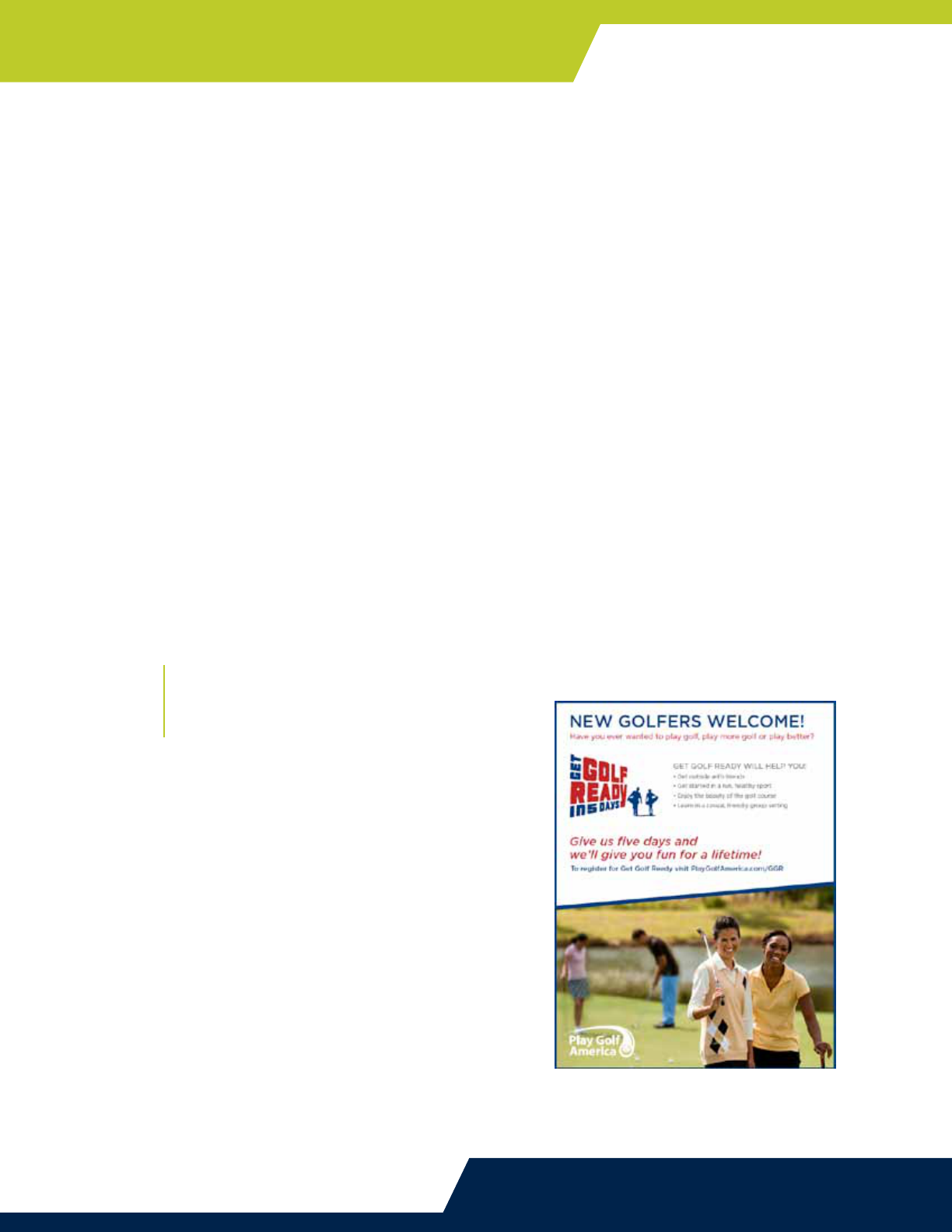
GOLF 2.0 PLAYER DEVELOPMENT PLAYBOOK
they’ve seen increases in both customer loyalty and revenue in the last seven months, netting
an extra $10,000 to $20,000 per month. This jump is attributed to an increase in rounds and
savings on marketing. Chan noted this strategy has completely changed the way he mar-
kets his course.
Facilities report some aordable advertising can also be purchased from radio and local cable
companies.
How to Develop Promotional Materials
for Your Programs
Use templates and collateral provided for each of the various Golf 2.0 Menu of programs
• Posters/Flyers
• Brochures
• Press Release Templates
• HTML Ads & Logos
Use resources to create your own materials
• Some of the templates found at Golf20.net can be customized (i.e., drop in your
logo or specific schedules and information about your programs)
• Use files and copy to create your own materials
Signs
Brochures
Ads
• Radio ads
PGA Professionals can let their aliation
work for them by incorporating the PGA
Professional logo into all promotional material,
and use the PGA stock documents and
templates when appropriate.
LOCAL MARKETING - Generate Students and Customers
30

GOLF 2.0 PLAYER DEVELOPMENT PLAYBOOK
Tracking & Reporting
Results
Why You Need to Track and Report Results
Your employer is interested in making money. If your programs are generating revenue,
do you think your employer would like to know? Do you think this could help your job security?
It is vital to capture key metrics on your student’s golf activity and to quantify the impact of your
Player Development programs to your facility’s bottom line. This is a crucial step as it quantifies
your skills as a revenue generator and the impact you’re making to the bottom-line number,
which you’ll use in your communications to your employer.
What to Track
1.
How many new golfers have you developed and retained?
2. How much have new golfers spent at your course?
3. How many total rounds have new golfers played at your course?
How to Track
There are several ways you can go about tracking results. The common thread to all methods
is tracking the rounds they play and the money they spend. Below are a few methods you
may use in tracking the progress of your students as they play golf at your facility
How to Track – Frequency Tracking Card
Frequency tracking cards can measure customer’s usage and spending at the facility,
which can be very helpful in quantifying the eectiveness of Player Development programs.
Give your new students a card when they start the program and oer some incentive (usually
points based on dollars spent) for using the card. Many Point-of-Sale (P.O.S.) systems oer
this functionality, as well as some stand-alone frequency card tracking systems. Look for more
information about these cards in the Deepening Engagement in Current Golfers initiative.
A great example from a PGA Magazine article on using Frequency Tracking Cards is
(found in Playbook Appendix.)
37

How to Track – Customer Database
While frequency cards provide an automated tracking system, a reality is that many facilities do
not have systems with this capability. As an alternative, customer databases can help you track
results. Databases can be through a POS system or they can be a simple database in a spread-
sheet. In addition to building a customer profile, a customer database can track:
• Program participation
Names of program and frequency
Registration fees
• Purchase activities
Green fees
Food & beverage
Merchandise/Equipment
Instruction
• Project combined totals to include breakdown of facility versus instructor revenue
An example Spreadsheet Template is found in Playbook Appendix.
How to Track – Phone Interviews
Telephone interviews with recent students can be a terrific way to reconnect with your students
since their last instructional session. It’s a personal touch which serves multiple purposes:
• Shows your student that you care about them and their game, which will
strengthen your relationship with the student
• Provides you the opportunity to promote further Player Development
programs at your facility
• Enables you to capture data about your students’ continued progression
as a golfer for the purposes of tracking and reporting
How to Track – Personalized Email Messages
Emails are another option to consider. While phone calls may be more personal and likely to
give you a higher rate of response, this digital technology may be more ecient for you.
Personal email messages can serve the following purposes:
• Strengthens the connection between you and your student
• Invites the customer back to your facility
• Collects data to quantify the eectiveness of your Player Development program
TRACKING & REPORTING RESULTS
38

GOLF 2.0 PLAYER DEVELOPMENT PLAYBOOK
Reporting
Developing comprehensive reports quantifying your results could be the most important step in
showing your value to your employer. Reporting should focus on detailing results that match the
objectives that you had set forth in your Player Development program business plan. Some sug-
gested results to report may include:
• Number of students entering your Player Development programs
• Number of golfers you’ve developed/retained (those students who then
played a round after their instructional program with you)
• Of the golfers retained, how many rounds have they played?
• Revenue generated following player development programs
Include breakdown by various departments (golf fees, F&B, merchandise)
• Consider reporting breakdown by targeted niche markets (women, families, etc.)
By capturing data about your students from frequency tracking cards, phone interviews or email
messages and logging that data into a spreadsheet, you’ll be able to report the above information.
“DetaileD tracking anD reporting of our player Development programs to
the leaDership team is vital. not only Do the results prove that what we are
Doing is relevant, but the information helps with Decision-making as it relates
to sales, marketing anD other company initiatives.”
scott szymoniak, pga Director of player Development, canongate golf clubs
Evaluating Results and Making Modifications
By the end of 2012, you’ll be able to access benchmarks comparing your Player Development
programs to other facilities that are similar to yours (based on facility type, pricing and location.)
Evaluating your results and comparing your facility to benchmarks can help you:
• Identify strengths and deficiencies in your Player Development programs and refine
your programs to make them even better (i.e., initial step for your next SWOT analysis)
• Pay attention to how your facility compares to benchmarks on the number of
golfers created and retained through your Player Development programs
• Identify what changes you should make to your planning process of future Player
Development programs
The process of evaluating your results is best completed in collaboration
with your employer and with proactive communication.
Utilizing the strategies found in this Playbook should be started in advance
of each new golf season.
39

GOLF 2.0 PLAYER DEVELOPMENT PLAYBOOK
APPENDIX I
Golf 2.0 Menu of Programs
Get Golf Ready
Get Golf Ready is the Player Development program designed to bring adults into the game in a fast,
fun and aordable way. It is a series of five lessons that helps students get on the golf course and
play. It is designed to be flexible, in order to integrate into existing Player Development initiatives.
Get Golf Ready aligns with Golf 2.0’s core strategies to Drive New Players and Engage Lapsed golf-
ers. Survey results have shown that Get Golf Ready is a great program to bring new customers to
facilities and turn them into long-term golfers.
Get Golf Ready includes three levels for you to integrate:
• Get Golf Ready – first step introductory program where teaching fun is priority
• Get Golf Ready 2 – next-step instruction to enhance skills and confidence
• Get Golf Ready Outings/Leagues – structured, yet very fun with casual playing opportunities
• Get Golf Ready for Women – use the same but more social format
To learn more about Get Golf Ready and become a host facility, visit PlayGolfAmerica.com/GGR.
TEE IT FORWARD
TEE IT FORWARD is the national campaign which encourages golfers to play the golf course at a
length that is best suited to their abilities. TEE IT FORWARD has the potential to speed up play and
allow your golfers to have more fun by utilizing the tees that provide the greatest playability and
enjoyment.
TEE IT FORWARD had great success in 2011 with survey results showing 70% of golfers had more fun;
47% played faster; and 52% sharing they were likely to play more often because of TEE IT FORWARD.
To learn more and register as a TEE IT FORWARD facility, visit PlayGolfAmerica.com/TeeItForward.
It’s Okay
It’s Okay is a list of 18 helpful hints for new golfers to consider when going out for a casual round of
golf. Hints include: “It’s Okay to throw the ball out of a bunker,” and “It’s Okay to tee the ball up in
the fairway.” The Rules of golf are important, but the It’s Okay hints can be a great way for new
golfers learning the game to have fun and enjoy golf.
To see the full list of It’s Okay hints, go to PlayGolfAmerica.com.
APPENDIX
41

Welcome to Golf Month
New for 2012, May is Welcome to Golf Month. This new promotion aligns with Golf 2.0’s core
strategies to Drive New Players and Engage Lapsed Golfers. Using PGA Free Lesson Month as
the foundation of the program, PGA and LPGA professionals can participate by oering four
hours of complimentary instruction and/or introductory programs, Welcome to Golf days,
bring a friend, clinics and more.
To register for Welcome to Golf Month, visit PGALinks.com.
Women’s Golf
A continued focus of Golf 2.0 is the women’s market, as we strive to grow participation among
women. Welcome female golfers by developing specific programming for women, focused on non-
intimidating and social entry into golf. Consider oering women’s leagues, clinics, discounts,
as well as variations on programs such as Get Golf Ready and Welcome to Golf.
Learn more about women’s golf at Golf20.net or post women’s programs on PlayGolfAmerica.com
using the Play Golf America Resource Center.
Family Golf Month
Family Golf Month can help achieve Golf 2.0 and Player Development objectives by attracting lapsed
parents and growing participation among youth. Promoted in July, Family Golf Month brings at-
tention to family golf programs nationwide, such as PGA Family Course, Kids Play Free and various
family-friendly golf outings, tee times, and special promotions geared toward families.
To learn more about Family Golf Month and register your facility visit PlayGolfAmerica.com.
Junior Golf
Increasing participation among junior golf is important for the future success of the golf industry.
The PGA of America oers many programs to increase junior golf participation. The PGA Sports
Academy is a fun and interactive program designed to develop juniors into long-term golfers using
five key areas, including golf and “near-golf” experiences, golf skills, sportsmanship, fitness and nutri-
tion. Other key programs include the PGA/USGA Course Access Pass, Kids Play Free and more.
To learn more or register for any junior golf programs, visit PGALinks.com
APPENDIX
This menu of choices has been developed to help achieve facility, golf
operation and Golf 2.0 goals. These represent a small portion of what is
available. For more information, assistance with registration and other
questions, contact PGA Member Joe Canny, PGA of America, (561) 630-1705.
42

GOLF 2.0 PLAYER DEVELOPMENT PLAYBOOK
APPENDIX II
SWOT Analysis Suggested Guidelines
Use the questions below for conducting your SWOT analysis. When conducting your SWOT analysis,
consider which components of your Player Development programs you can improve and the potential
impact to your programs from any components that you’re unable to improve.
Planning
• Do you develop an annual plan for Player Development?
• Who is involved? Head Professional? Instructors? GM/Owner/Board?
• As a team, do you discuss the desired outcomes from programs, how to achieve these,
andwhat resources will be required?
Customers
• How many rounds are played at your facility? Are you pleased with this number?
• How many unique customers do you have? How often do they play?
• What do you know about your customers?
• Do you survey them? Have you asked them about their satisfaction?
Programming
• What types of Player Development programs do you oer? Are they working?
How do you know?
• Do you have programs targeting new/former golfers? Women? Families?
Seniors? Juniors? Are they working?
Budgeting
• Do you develop budgets for your Player Development? What type of ROI
do your programs generate?
• Is your budget sucient to maximize success?
Instruction Team
• How many instructors do you have?
• Are your instructors in line with overall plans for your facility?
• How important is teaching new and former golfers to your instructors?
Do you require that they focus on new golfers?
• Do you know if your instruction programs generate rounds and revenue for the facility? If so, how?
• Can you enhance how instruction programs are tied in with generating rounds and revenues?
• Do you oer any type of incentives to have your instructors encourage their students to play?
43

APPENDIX
Sta
• Is your golf shop sta knowledgeable about all the programs being oered at your facility?
• Are your sta members engaged with your programs?
• Do your sta members deliver a welcoming experience for golfers of all abilities?
• Does your sta know the importance of being sensitive to new and former golfers?
Marketing
• How do you promote your programs within your facility?
Posters, signs, emails
Members, spouses, families
Social members, pool members
Does this communication reach your target audience?
Do you promote instructional opportunities to any of your outing groups?
• Do you use digital media?
• Do you use Social Media?
• Do you promote your programs to the local community, outside of your facility?
Do you work with local companies/community organizations?
Do you promote instruction programs to companies that already
have leagues at your facility?
Do your Professionals go into local schools to teach golf? If so, do they promote
your junior and family programs? Do they invite faculty and parents?
Do you host or support any special events within your community (i.e., participate in
events to promote your facility/programs or provide quick golf lessons?)
• Do you pay for advertising to promote your Player Development programs?
Retention – Results
• Are your introductory/Get Golf Ready classes creating new golfers?
• After completing introductory/Get Golf Ready classes, how many of your
students continue to play or practice? How often do they come back?
• How often do you communicate with them?
• What types of retention programs do you oer?
Next-step instruction?
Beginner leagues or outings?
Loyalty cards to play or practice?
• Have you ever asked them what they would like to do?
44

GOLF 2.0 PLAYER DEVELOPMENT PLAYBOOK
• Do your instructors understand the importance of getting their students to “play”?
• Do you encourage your newer golfers to use TEE IT FORWARD, It’s Okay,
or fun formats when they play?
Tracking Results & Reporting
• In addition to participation numbers, do you track results to try and measure
the impact of your Player Development programs?
• How do you track these results?
• After students complete programs, do you track their frequency or spend on:
Continued instruction
Playing or practice
Equipment and merchandise
F&B
• Do you tally the total impact of these eorts? Do you break it down as to new
business generated for the facility vs. instructor?
• Do you develop reports to share with your employer?
Golf Course/Facility
• Is your golf course beginner-friendly?
• Do you have sets of tees providing an executive/short course experience?
If so, do you have scorecards from this distance?
• Do you oer opportunities and have the fee structure available to play
“quick” rounds of golf? 9-holes? 3 or 6-hole loops?
• Do you promote these tees and quick opportunities for golfers to have more
fun while learning to play?
Facility Welcoming Environment
• Are your course policies appropriate for today’s society?
• Have you ever made secret shopper calls to your facility to see what type
of welcoming experience is delivered?
• Does your golf shop and operations sta make golf welcoming? How often
do you speak with them or train them?
• Does your golf course grounds sta make golf welcoming? How often
do you speak with them, or train them?
• Do you work closely with rangers/marshals on how to approach new golfers?
• Does your signage use negative language (i.e., don’t do this, or not allowed)?
45

GOLF 2.0 PLAYER DEVELOPMENT PLAYBOOK
APPENDIX
APPENDIX III
Interview Call Guidelines
Conduct follow-up calls with your students at the conclusion of your golf season. Below
are suggested guidelines for conducting the call:
• Start with a short introduction about a personal memory or enjoyable
moment you had teaching them
• Ask if they are still playing and approximately how many rounds they
have played at your course since you last worked with them
• Ask if they’ve taken advantage of any food and beverage or merchandising services
– if so, how was their experience and try to determine how much they spent
• Ask them about any areas of the game they are struggling with and be sure
to promote any future Player Development programs
• Close the call with a personal message thanking them for giving them the
opportunity to teach golf, remind them that golf is fun and that your facility
oers the perfect atmosphere for them to enjoy the game
Log the results of these questions into a spreadsheet for each student (see template in
Playbook Appendix) for tracking and reporting purposes.
APPENDIX IV
Personalized Email Guidelines
In the email keep it simple. Start with a short introduction with a personal note about a
memorable or enjoyable moment you had teaching them. Ask them if they are still
playing, and approximately how many rounds they have played at your course, since
you last worked with them.
Be sure to promote any future Player Development programs that you may have
upcoming. Close the email with a personal message thanking them for the opportunity
to teach golf, remind them that golf is fun; and that your facility oers the perfect
atmosphere for them to enjoy the game. If the customer responds back to your email and
answers your questions, log the results into a spreadsheet for each student (see template
in Playbook Appendix) for tracking
and reporting purposes.
35
46
